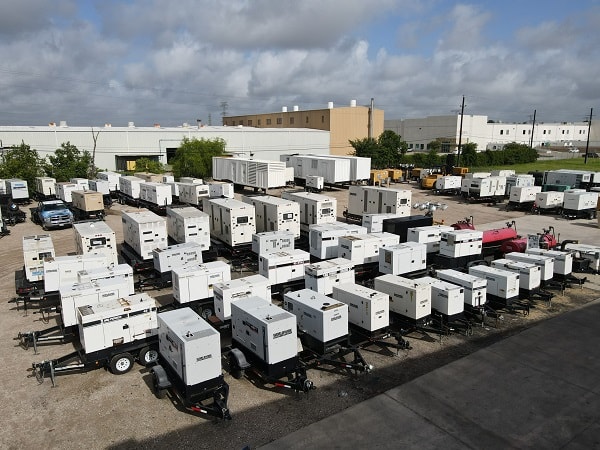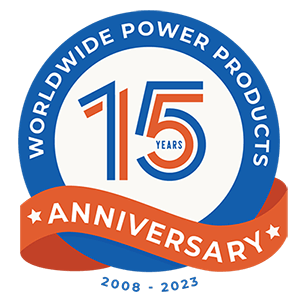Generator Silencers – Different Types & Sound Ratings
For many business owners and project managers, one of the biggest concerns about investing in a generator has been the noise control.
Noise pollution is a real problem in many parts of the world and, like air pollution, it can have negative effects on the people it reaches.
But just as carbon emissions have been dramatically reduced in the last few decades due to engineering improvements and stricter regulations, modern sound attenuation technology is now able to reduce much of the engine noise emitted when a generator set is running thanks to the use of an exhaust silencer.
Depending on your facility’s environment, the application, and local ordinances, you may require an advanced level of silencing, or minimal sound dampening may suffice.
If a new generator set is of an open configuration, it typically will not come with a silencer, but many manufacturers offer them as accessories. Generator sets that are packaged in an enclosure would include a silencer of sorts. Use the following info to learn about the different types of generator silencers available today and whether adding a silencer to your genset is worthwhile.
Types of Generator Silencers
Generator silencers come in a wide variety of designs that vary in the way they work, their size and shape, and a few other features. The main types are:
- Reactive silencers, mute sound by bouncing it around inside one or multiple chambers. This design works best for low to moderate noise level demands.
- Absorptive silencers are used in more demanding environments and have a greater sound attenuation rating.
- Reactive/absorptive silencers combine the mechanics of each style into one model with the chamber(s) lined with insulation.
- Resonator silencers are a less common type, designed to cause less back pressure and are less effective in sound attenuation.
Among these types, silencers in cylinder, disc, and rectangle shapes are very common, with inlets and outlets able to be located on both sides (Side-in, Side-out), both ends (End-in, End-out), or one side and one end (Side-in, End out or End-in, Side-out) to work with your system.
Cylinders are a cost-effective option with the flexibility to be installed either horizontally or vertically, while discs and rectangles are preferred where space is limited, such as inside a sound-attenuated enclosure.
Some heat recovery systems and exhaust heat exchangers qualify as silencers known as heat recovery silencers because they reduce sound while capturing much of the energy that would otherwise be given off as heat. This energy can then be used as a heat supply for other external equipment, making the system both quieter and increasing efficiency.
Catalytic silencers tackle the problems of both carbon emissions and noise emission at the same time by incorporating sound attenuation into the catalytic conversion system required to meet Tier IV EPA emissions standards. Visit our page on generator tier ratings to learn more.
Rating Generator Silencers
Silencer ratings have evolved over time to make it easier for end users to have an accurate understanding of the sound attenuation to expect with a given silencer. In 2014, the Electrical Generating Systems Association (EGSA) took steps to create a standardized rating system for silencers.
The result was eight classes of ratings from Class 1 up to Class 8, with Class 8 being the highest-rated level of sound attenuation as measured in dBA, the measurement standard for sound as felt by the human ear. Within these classes, there are several general application grades commonly used in the industry: industrial (the lowest strength), residential, critical, hospital, and extreme.
| Grade name | Level of sound attenuation (measured in dBA) |
|---|---|
| Commercial Grade | 14 – 20 |
| Residential Grade | 19 – 25 |
| Critical Grade | 25 – 35 |
| Critical Plus | 30 – 38 |
| Super Critical Grade | 32 – 42 |
| Extreme Grade | 40 – 52 |
| Super Extreme | 45 – 60 |
Remember, these are reduction ranges. So, for example, if you have an enclosed generator that emits 90 dBA at full power, a hospital-grade silencer might be able to cut that level in half. Assuming it was placed a fair distance away from patients, this would make the generator a good fit for an actual hospital, where patients need quiet to assist recovery.
The placement of the generator is an important aspect of silencer performance, as sound level grades are typically awarded based on a distance of 7m (23 feet).
You will need to bear that in mind when shopping for a silencer, as buying a hospital- or extreme-grade silencer may be overkill if you have enough room for sound to dissipate naturally before reaching human ears and you can get by with a lower-grade silencer.
OSHA guidelines, local ordinances, and other requirements will set the parameters on how much sound you can legally and safely allow.
Find Your Power Generation Solution Today at WPP
Worldwide Power Products is a leading provider of new and used generators, as well as parts and accessories for backup power generation equipment. We carry the biggest brands such as Kohler, Cummins, and Caterpillar in a huge variety of sizes and for whatever applications you plan to deploy them in.
Shop Our Inventory












